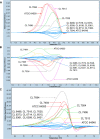Analysis of strain relatedness using high resolution melting in a case of recurrent candiduria
- PMID: 23343107
- PMCID: PMC3561232
- DOI: 10.1186/1471-2180-13-13
Analysis of strain relatedness using high resolution melting in a case of recurrent candiduria
Abstract
Background: Several genotyping protocols have been described to study Candida albicans strains with different sensitivity values. In this study we have analyzed the genetic relatedness and the antifungal susceptibility of several Candida albicans strains isolated from a patient who from suffered recurrent candiduria for a period of five years. Strains were genotyped using Microsatellite Length Polymorphism (MLP) with three microsatellite markers (HIS 3, EF 3 and CDC 3), and a new method based on high resolution melting (HRM) was developed to analyze the microsatellite region. This method was compared with the conventional technique that uses capillary electrophoresis.
Results: MICs of the isolates showed the existence of fluconazole susceptible and resistant strains. An inter-colony test using single concentration (8 and 16 mg/l) of fluconazole revealed the coexistence of both fluconazole susceptible and resistant strains. Both genotyping analysis methods showed that all the patient's isolates had a clonal origin. HRM analysis method developed was able to accurately establish strain relatedness and presented a discriminatory power of 0.77.
Conclusions: Although HRM analysis method presented a lower discriminatory power compared to methods based on capillary electrophoresis, it provided a more cost-effective and suitable alternative for genotyping C. albicans in a clinical laboratory.
Figures
References
-
- Lockhart SR, Fritch JJ, Meier AS, Schroppel K, Srikantha T, Galask R, Soll DR. Colonizing populations of Candida albicans are clonal in origin but undergo microevolution through C1 fragment reorganization as demonstrated by DNA fingerprinting and C1 sequencing. J Clin Microbiol. 1995;33:1501–1509. - PMC - PubMed
Publication types
MeSH terms
Substances
LinkOut - more resources
Full Text Sources
Other Literature Sources
Medical


